<
Guide to Sleep Trackers
Dec 17, 2022

Dr. Darren Bowles
'Do people really need sleep trackers to tell them they've slept well or poorly?'
'Are they the life-changing tool people claim them to be, or are they just justifying their expensive gimmick?'
The last few years have seen a surge in the world of sleep tracking. We've seen an increased focus on accurate data, new technology entering consumer markets, and budget alternatives gaining traction against established devices.
If you're considering a new device, this article will provide an overview of sleep tracking and a review of the available devices.
Why do people track sleep?
The main reason people track their sleep is not to be told they slept well, but rather to help improve their sleep.
Most sleep trackers monitor:
How long it takes you to fall asleep (Sleep Latency)
How often you wake up during the night ( Sleep Efficiency)
How long you spend in different stages of sleep ( Sleep Stages)
Monitoring your sleep patterns over time is another reason people invest in sleep trackers. By tracking your sleep on a regular basis, you can identify any long-term trends. This can be useful for tracking the effectiveness of any treatments you may be using.
In addition to measuring your sleep quality, some sleep trackers measure your heart rate, oxygen levels, breathing rate, body temperature, and much more. This information has the potential to inform you about: your recovery from exercise, the impact of habit changes, the presence of illness - to name a few.
Tracking this information can help you identify patterns and habits that may be affecting your life and your health. To take the guess work out of it - we’re building Cambrean - an independent app that looks at your data and the relationships between them + much more. Feel free to sign up ( for free) here.
It’s important to note that sleep trackers are not 100% accurate, when compared to laboratory measurements. To understand how sleep is measured - take a look at ‘ Tracking your Sleep’.
Which Sleep Tracker is Best?
The best sleep tracker is the one that suits your needs. Let’s explain:
Someone who just wants to track their sleep would be more than served by the Oura, whereas someone who wants to record their sleep and have a device that can send texts/ tap-and-go pay - may be best served by a smartwatch. Similarly, some people can’t stand wearing watches when they sleep, and may want their mattress to do it all. So what you want, and what what you can wear, does factor in to your buying decision.
To help you decide which device is best suited to you, we will be reviewing the top sleep trackers under the following headings:
Design
Functions
Accuracy
Battery Life
Price & Subscriptions
Pros & Cons
What does Cambrean do?
Wearable devices have become increasingly more accurate and reliable in recent years. This tracking has the potential to provide huge insight and the ability to improve your life. Many companies claim to offer personalized insights, but when you look closer, their insights are usually general summaries (e.g. "Your deep sleep was 30 hours this week") or obvious suggestions (e.g. "Alcohol has affected your sleep").
Cambrean enables you to view all your data on one platform. With Cambrean, you will discover the connections between your lifestyle and health, and get tailored insights into your wellbeing. We don't use leveraged scores or secret algorithms; we understand that your data is personal, so your insights should be too.
We're currently running a closed Beta. Sign up for free here to access our web-app and closed mobile app beta.
Sleep Trackers
Oura Ring
The Oura ring is a sleep tracking and fitness device that is worn on your chosen finger 24/7. It’s a small, lightweight ring that uses advanced sensors to track a range of physiological metrics, including heart rate, heart rate variability, body temperature, movement, sleep quality.
Design
Hardware Design
You can get the Oura ring in a variety of different styles.
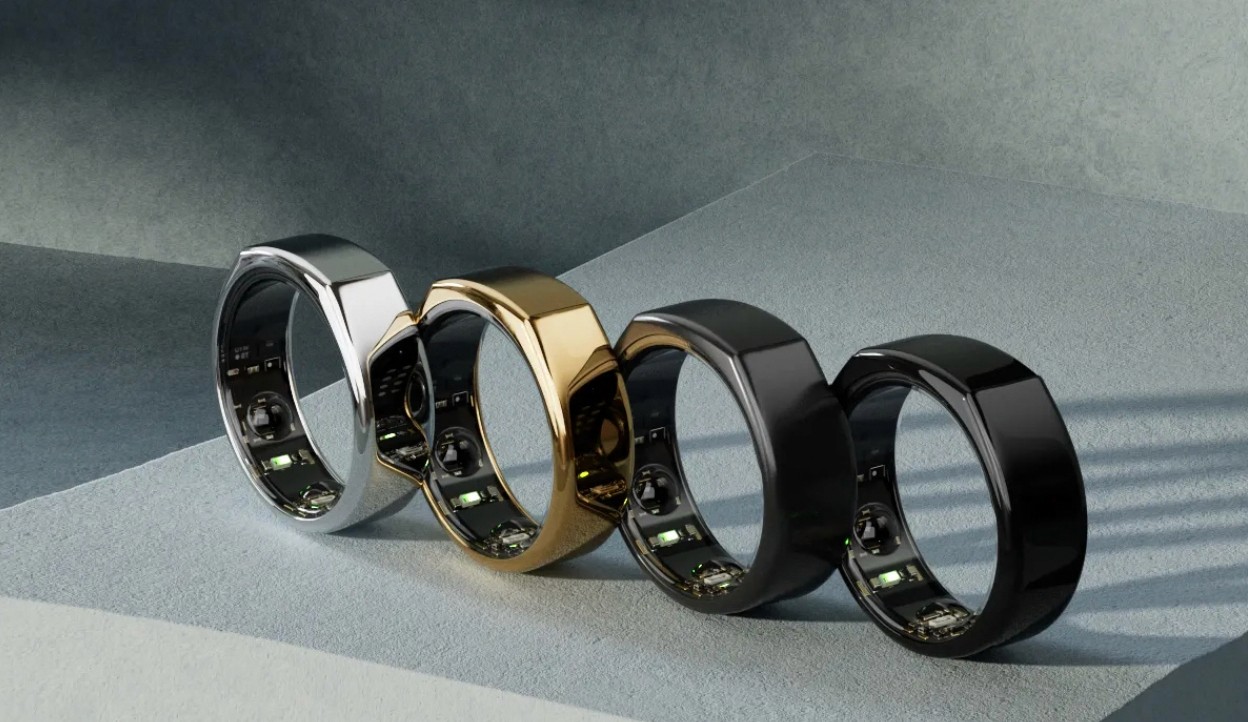
The ring looks great for everyday wear, with no indication that it's a tracking device. You can choose a style that's as stylish or casual as you like. Inside the ring is the sensor interface. Don’t fret about guessing the right size of ring, Oura sends a sizing kit before delivery to ensure a custom fit.
Software Design

Above is the Home Page you are greeted with when you open the Oura app. Like many devices, Oura leverages your data to generate scores (and like most companies, these scores are generated by algorithms that are kept behind closed doors). The scores on offer are:
Readiness Score: How ready you are for the day
Sleep Score: How well you slept last night
Activity Score: How you balance your activity and rest
Readiness, Sleep, and Activity each have their own page. With each page, you can view the raw data that contributes to each score. This data is shown in buttons or graphs, and you can scroll through your calendar to view the related data for different days.
Functions
The Oura Ring is far from just a sleep tracker. Below we show what Oura tracks, with some qualifiers in needed areas:
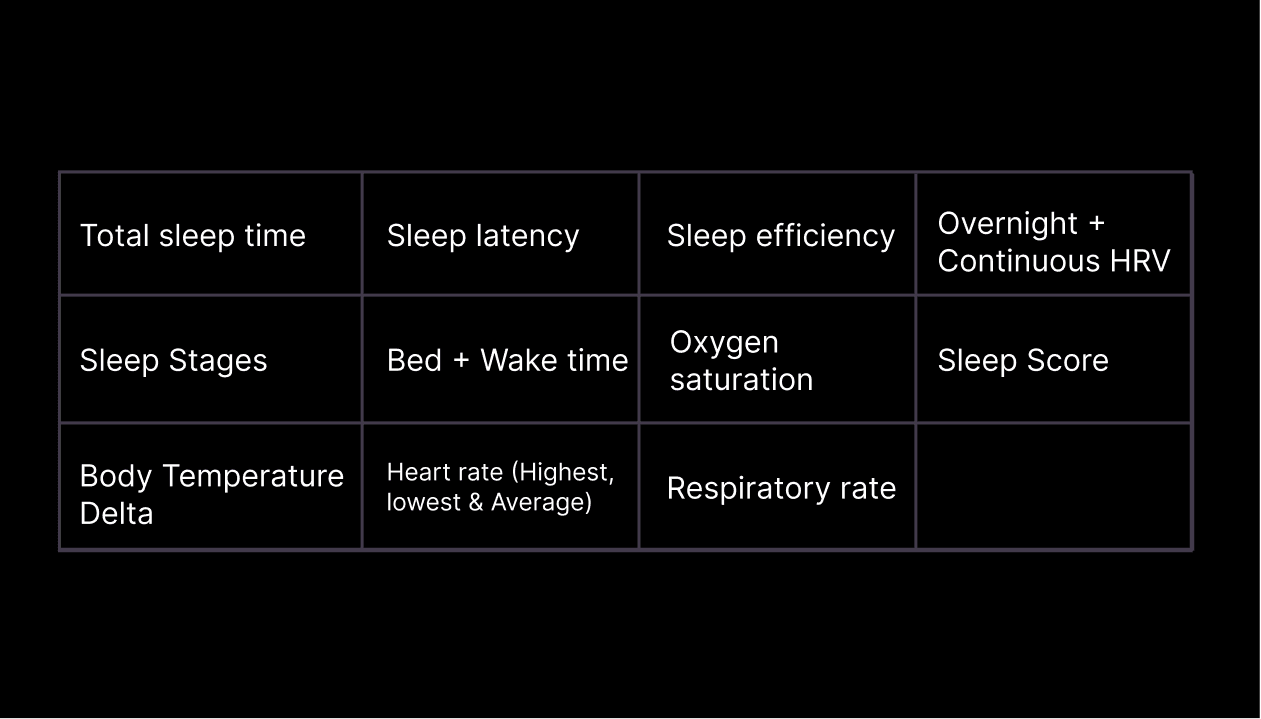
Oura has two rings on offering at present - The Gen 2 and Gen 3. The main advantage that the Gen 3 has over the Gen 2 includes:
24/7 Heart Rate Monitoring
Workout Heart Rate Tracking
Period Prediction
Improved Sleep Monitoring
Accuracy
The Oura ring uses a variety of sensors to track your metrics:
A PPG (photoplethysmography) sensor - using infrared light to measure the change of blood flow in your finger, which detect sleep staging, changes in heart rate and blood oxygenation levels.
An accelerometer, which measures movement - detecting when a person is awake or moving.
A temperature sensor, which measures the temperature of the finger and can help determine when a person is in a state of sleep.
A gyroscope, which measures the orientation of the hand and can help detect when a person is in different positions during sleep (such as lying on their back, side, or stomach).
When compared to laboratory settings, the Oura ring fairs well. It does have a tendency to underestimate your total sleep time and REM sleep, while overestimating your deep sleep, but overall it is around 80% accurate when predicting your sleep stage when compared to laboratory settings.
Battery Life
With all these devices, it depends on how often you use it, especially if you use Oura to track all your workouts. On average, Oura lasts 2-3 days before requiring a recharge.
Price & Subscriptions
Oura implements a subscription for the Gen 3. This means that any of the features listed above are not accessible, unless you fork up for the subscription. The price of the ring can vary based on what style you choose, but on average:
Gen 2: $ 299
Gen 3: $367
Subscription: $6/month
Pros & Cons
Pros :
Easy to wear
Lots of accurate data
Supported by Research
Good Activity and Workout Functions
Cons:
One Size does not fit all
Difficult to wear for Strength Training
Data behind a Subscription
Eight Sleep
Founded in 2014, Eight Sleep provides technology, in the form of a mattress or mattress cover, to capture your biodata while you sleep and regulate your temperature according to your preference and needs.
The active grid is the core component of Eight Sleep’s technology. It contains sensors that detect your biodata, and is connected to the Eight Sleep Hub, a water reservoir that pumps water through channels in the grid to control the mattress temperature. All of this is controllable with the Eight Sleep app, which also displays your data.
Design
Hardware Design
The two packages on offer from Eight Sleep include the:
Pod Pro Cover
Pod Pro Mattress
Pod Pro Cover
The Pod Pro Cover zips onto your mattress and is connected to the The ‘Eight Sleep Hub’ ( water reservoir). Although the setup includes zipping the cover onto your mattress and connecting the tubes to the Pod, it really is quite simple - taking about 30 mins to setup. Size specifications can be chosen on the Eight Sleep store.
Pod Pro Mattress
The mattress is pretty much what you imagine, with the active grid built into the mattress.
It comes in double, queen, king and super king size, while offering 6 layers of comfort - including a foam and a premium base layer.
Software Design
The app displays your sleep data through reports, charts, and raw data, with a tagging system that allows you to add context to your data.
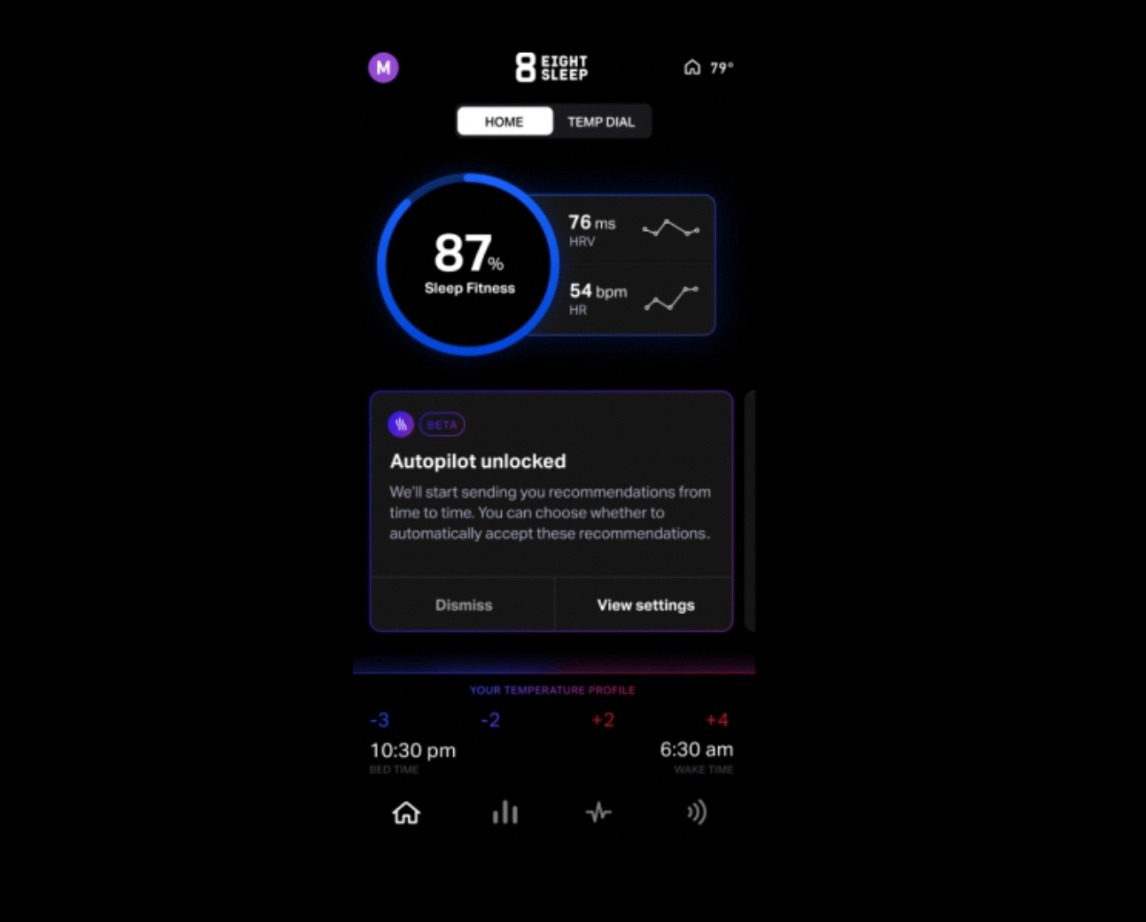
The temperature of the cover/mattress can be adjusted here too. You can adjust the temperature of either side of the active grid, allowing you and your partner to have different temperatures. The app also provides active feedback based on your data and tags, giving you insight into your data.
Functions
Eight Sleep aims to give you all the data you need without the need to wear a device. Below are the functions of the Eight Sleep Pod/ Mattress, with qualifiers in the necessary areas:

The chilling and heating capabilities allow you to reach your optimal temperature while you sleep, which is known to improve the quality of your sleep. This feature operates as an AutoPilot (subscription only) - meaning no inputs are required by you. The Eight Sleep Mattress & Pod can also heat/cool either side of the bed allowing you and your partner to sleep at different temperatures.
The main difference between the Mattress and Pod are the mattress' additional functions, which include:
Heat Dissipation throughout the Mattress
Spinal Support ( Firmness)
Pressure Relieving Material
Accuracy
At the time of writing, there is no peer reviewed research available that puts Eight Sleep's sleep tracking head to head with laboratory settings. This will likely not be the case for long, as they have recently published research about the accuracy of their respiratory algorithm here.
Battery Life
N/A
The Eight Sleep packages work as plug-in devices.
Price & Subscriptions
Naturally, the prices change based on the size of the mattress/ cover you are looking for:
Pod: $2,200 - $2,500
Mattress: $3,000 - $3,800
Subscription: $18/month
The subscription gives you access to the AutoPilot feature and their Sleep Insights, whether this is worth it is entirely up to you.
Pros & Cons
Pros
No wearable
Cooling/Heating Capabilities
Cons
Price ++
Paid Subscription for Features
Device Noise
Whoop
Whoop is a fitness strap that measures various elements of physical, activity, and sleep. The Whoop strap can be worn on the wrist, upper arm or anywhere where there is a snug fit. Whoop’s main differentiator is in the depth of information it records, and is touted by athletes and users alike to be the best amongst the rest.
Design
Hardware Design

The colour and design of the strap can be customised based on preference, and there is a large selection to choose from. What differentiates Whoop from other similar devices is the lack of screen, so if you are someone who likes to look at their data in real time - you may benefit more from another device. Whoop’s guidelines suggest that the strap should be worn at the wrist, but users often place the strap where is most convenient - usually with no compromise in accuracy.
Software Design
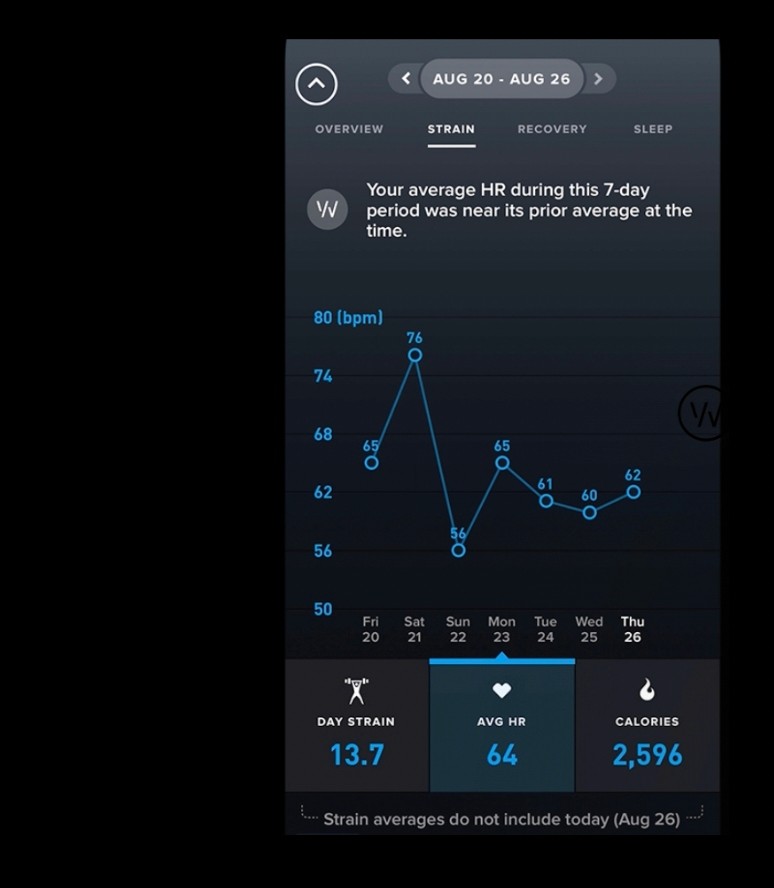
Whoop’s app is more detailed than its competitors. The data is typically displayed using weekly/monthly reports, graphs, recovery & ‘strain’ scores, and raw data. The charts and graphs display all manner of data, from your sleep data to your exercise data, and its journalling function allows you to add context to your data easily.
Functions
Whoop gives you a detailed view of your data, personalised recommendations around your sleep, as well as the capability to join communities to share your goals with. We outline the main functions of Whoop below:
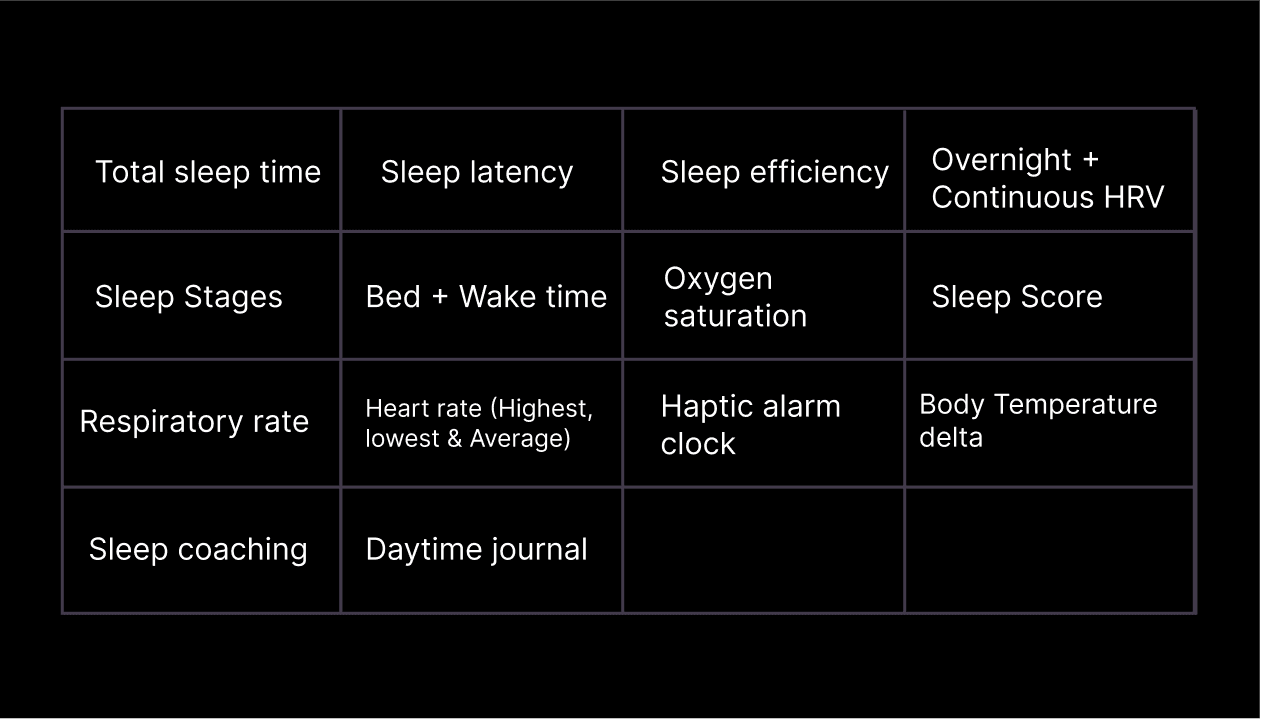
Its Sleep Coach feature ( shown below) gives you guidance on when the best sleep times are for you, while the journalling ability allows you to give context to data, which can prompt insights from Whoop
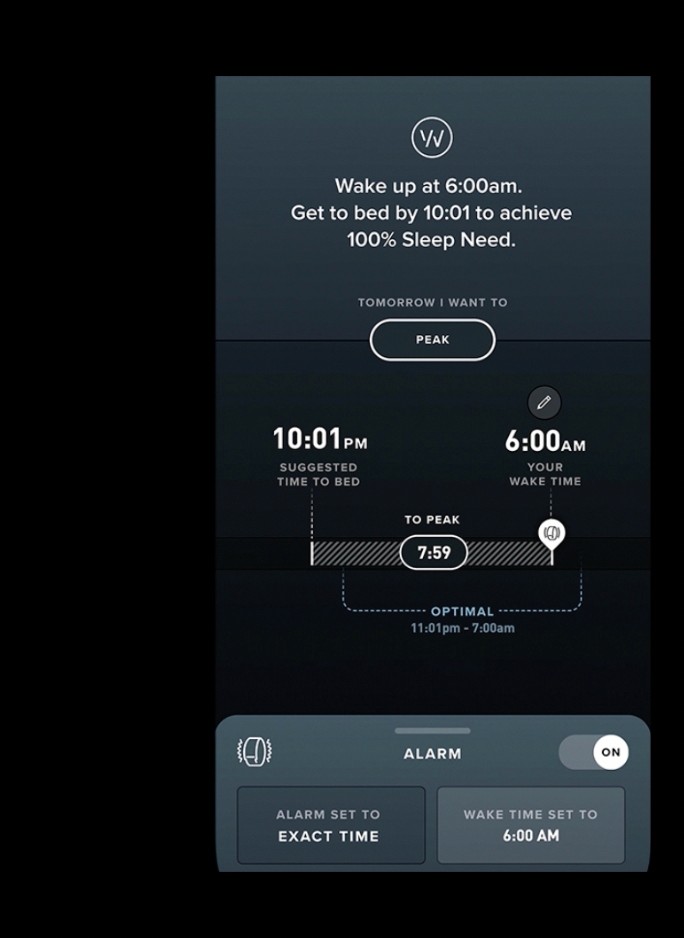
Accuracy
There are some research papers backing Whoop’s accuracy, however, the number of people in the studies are quite low, and the methods of the research are occasionally questionable e.g. manually inputing sleep start time rather than depending on the device to accurately detect this.
Their recent Pregnancy Coach research also relies on fairly skeptical methods. This study included 241 users, collecting data from a self reported in-app survey, not including their medical histories, or defining other pertinent variables that can influence HRV.
Whoop are definitely moving in the right direction with research, but we will wait for further peer reviewed before passing judgement.
Battery Life
The Whoop battery life is typically 3-4 days, again fluctuating with how active you are with the device.
Price & Subscriptions
The Whoop 4.0 strap is included in the monthly subscription models. These models include:
Monthly Membership: $30/month ( Minimum: 12 months)
Annual Membership: Pay $300 annually ($25/month)
24 Month Membership: Pay $480 upfront ($20/month)
Pros & Cons
Pros
Good Battery Life
Good Depth of Data
Comfortable to Wear
Cons
Unclear algorithms behind the scores
Price
No Live Data ( no screen)
Fitbit
Considered to be the entry point to the world of self-tracking, the Fitbit devices are wrist worn tracking devices that monitors your movement, sleep and health metrics. Unlike other entries so far, newer models of Fitbit has other functions like the ability to manage phone-calls/texts and contactless payments.
Unlike previous entrants, there are various types of Fitbit devices including:
Fitbit Sense: GPS, contactless pay, Spotify, Alexa/ Google Assistance & ability to track your biometrics, stress levels and heart health.
Fitbit Versa : GPS, contactless pay, Spotify, Alexa/ Google Assistance & ability to track your biometrics.
Fitbit Charge: GPS, contactless pay & ability to track your biometrics.
Fitbit Inspire: the most basic model with tracking function and call/text message notifications.
Design
Hardware Design
There is not much to the Fitbit device designs. Whether it's the Fitbit Sense, Versa, Charge, or Inspire - all Fitbits look like a standard watch. The Versa and Sense have a wider screen, while the Inspire and Charge have a narrow- band like aesthetic.

Software Design
The Fitbit Watch is very intuitive and basic. The clock-face can be changed to a template of your preference, and starting a workout take a few clicks of a side-button.
The Fitbit app continues this intuitive nature, highlighting the amount of steps taken per day. The sleep stages are viewed via a hypnogram and all data is viewed on a day-day basis.
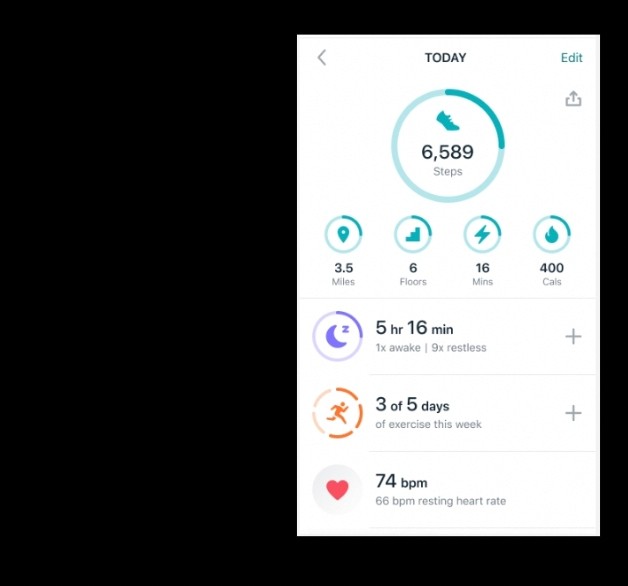
Functions
As always, we will focus on the sleep capabilities of the devices. The Fitbit Sense is the only device to offer body temperature recordings during the night, but the rest of the functions are present in all the Fitbit devices:
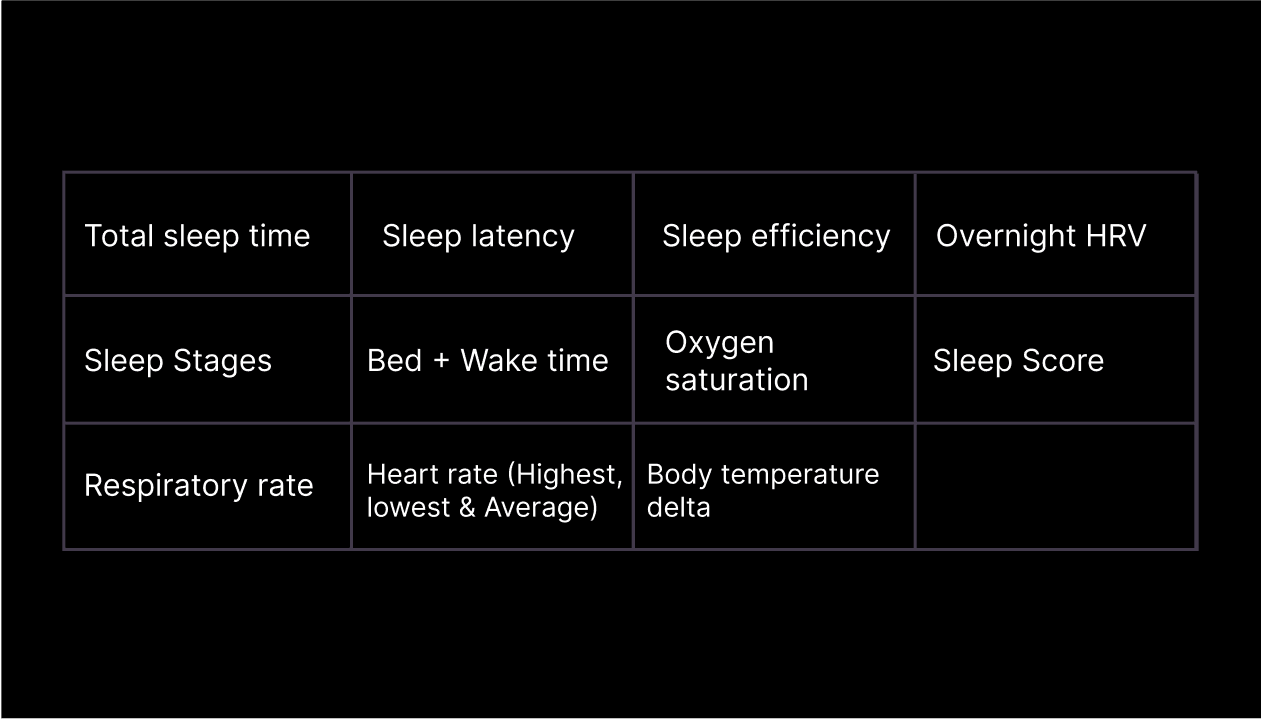
Accuracy
Fitbit devices are by far the most extensively researched and the results show that many of the devices are reasonably accurate, but don't hold up to laboratory standards. Most devices are useful for identifying sleep-wake patterns, determining the duration, pattern, and quality of sleep.
When it comes to HR and HRV, Fitbit is definitely playing catch-up with its competitors. Most of the research showing the inaccuracies, of which there are many, of Fitbit's HRV are based on their older models. Their newer PPG sensor should be on par with competitors measuring at the wrist - but research is needed to validate this.
Battery Life
The average battery life between the devices is 7 days. If you use the GPS tracking regularly or alter the settings of your clock face to always on/bright, you can expect the battery life to decrease to about 3 days
Price & Subscriptions
Similarly to other devices, the price of Fitbit varies based on the model you choose:
Fitbit Sense 2: $250
Fitbit Versa 4 $200
Fitbit Charge 5: $120
Fitbit Inspire 3: $100
Subscription: $9.99/ month
Behind the Premium Fitbit subscription lies your sleep & stress insights, readiness scores, personalized insights.
Pros and Cons
Pros
Ease of Use
Relatively Low Cost
Cons
Tracking Errors
Not aesthetic
Apple Watch
The Apple Watch is a fitness tracker and smartphone wrapped in one. You may think there would be a compromise in performance with this array of functions, but, aside from battery life, the Apple Watch holds its own against the dedicated trackers. There are several Apple Watches to choose from, with different functions and prices - we will specify whether certain features are specific to certain devices below.
Design
Hardware Design
As the name portrays, the Apple Watch looks and feels like a standard watch. Apple allows you to choose the style of case and strap, along with the size of the screen. The larger screen ( 41 and 45mm) of the later models (Series 7 & 8) added some well needed readability and overall the watch is simple and straight forward to use.

Software Design
The latest OS for the Apple Watch is the WatchOS9. Along with the standard UI that allows you to access apps and view your health data, the new OS introduces:
New Watch faces
Medications tracking app
Sleep stage tracking
AFib History
Custom workout inputs
Apple Watch Mirroring
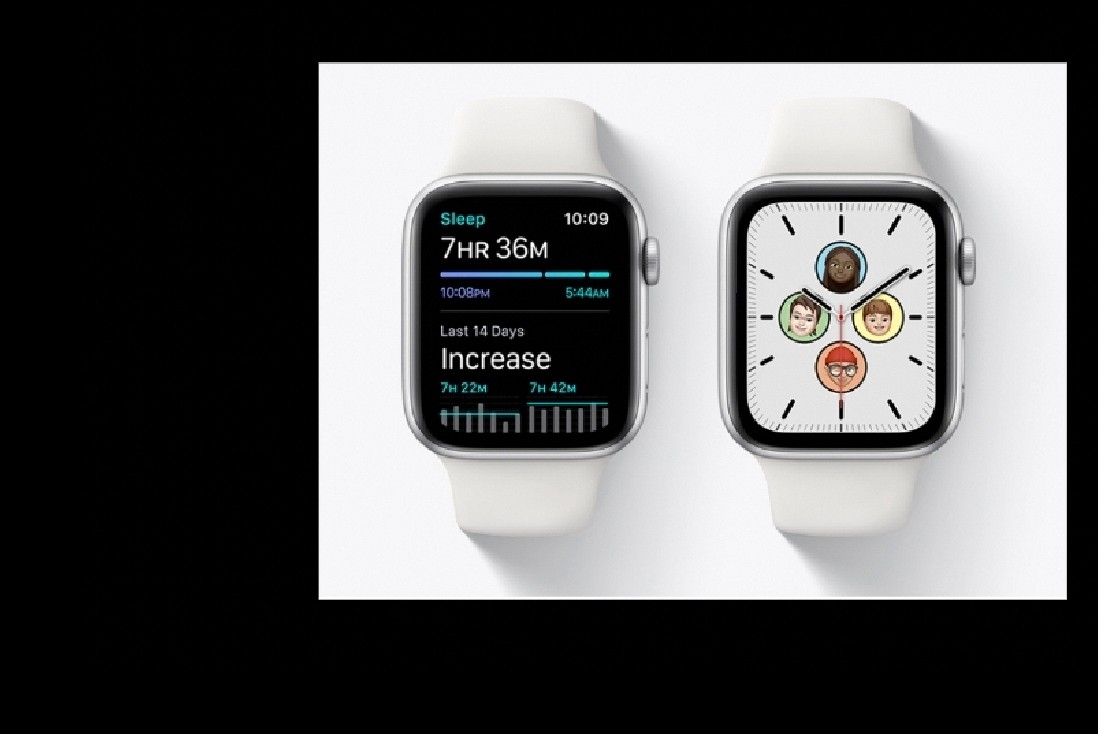
The tracked data can be viewed on the watch or on your phone using the Apple Health app, which, compared to other devices, is a bit of a let down. Apple Health was never supposed to be your data dashboard, but rather an interface for third parties to gather your data. You can favourite your chosen metrics for ease of use, and view your data in charts and graphs, but from a design perspective, it can sometimes be quite tedious.
Functions
Below are the functions that relate to Sleep for the Apple Watch Ultra, the latest addition to the Apple Watch selection. Compared to the Series 8, the Ultra offers a more rugged build with additional features for hiking, sea-diving and safety features.

Accuracy
One main study has been used to look at the validity of the Apple Watch in the realm of sleep. Although a low sample size, the Apple Watch has been found to be accurate when it comes to sleep, with only a 5-6 minute difference in sleep onset and wake-up times compared to an actigraphy-based sleep tracker ( Phillips Actigraphy).
Like others, this research is very limited, and would benefit largely from further studies.
Battery Life
Perhaps one of its greatest drawbacks, the battery life of an Apple Watch typically lasts between 1-2 days. Even with the caveat of - ‘it depends on how much you use it’, the battery life does not fair well against other competitors.
Price and Subscription
Below are the prices for the main Apple Watch Models, unique to other entrants - no subscription is required to access your data with the Apple Watch:
Apple Watch Ultra: $800
Apple Watch Series 8: $400
Apple Watch SE: $250
Pros & Cons
Pros
Huge amount of function
Accuracy
Design
Cons
Can be uncomfortable to wear
Battery Life
Apple Health not user friendly
Alternatives
Garmin Venu 2
Famed for its GPS accuracy, Garmin offers a wide range of products including, sport watches, smartwatches and fitness trackers. If you’re looking to Garmin for just sleep tracking, we would urge you to look at the alternatives, as the Garmin is leveraged towards endurance based activities rather than sleep
Muse S Headband
The Muse Sleep headband touts itself as an EEG (laboratory equipment) for your sleep. Although it has a tonne of potential, it does not seem to realise this yet. When the MUSE headband develops further, it will be a serious contender on the list, but until then, we will stick with the devices above, which offer more functionality and dependency.
Withings ScanWatch
An often looked over option, Withings ScanWatch is a great device with competitive functions and insights. The Withings watch looks the most like a traditional watch with a decent Health Mate app and has the potential to give the incumbents a run for their money with time.
Comparison Table

Summary
Sleep trackers can be a useful tool to gain insight into your sleep habits. Picking the device that suits your needs is one of the most important steps, as a mismatch between your preferences and the devices function can lead to it ending at the bottom of the drawer.